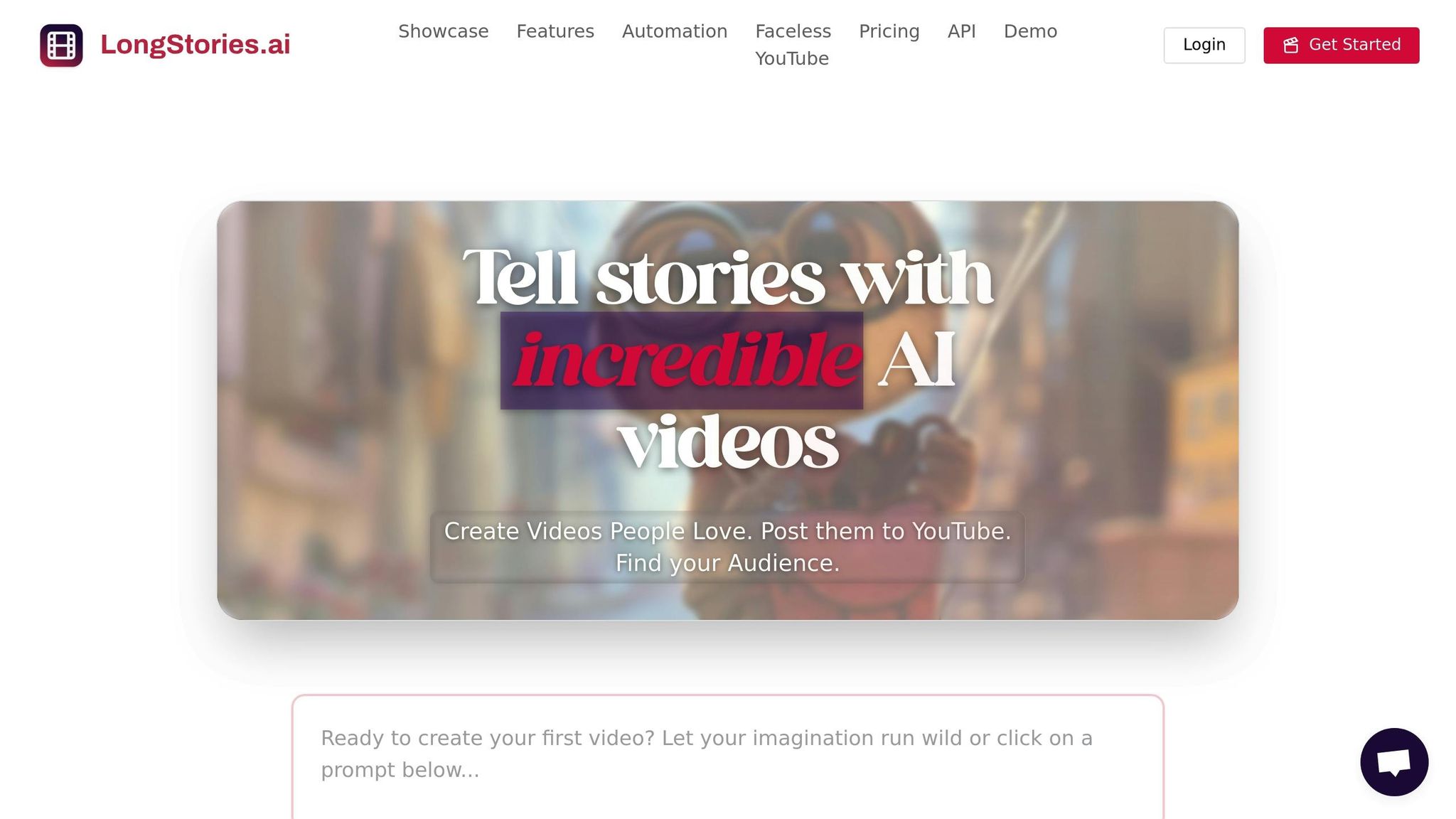
LongStories is constantly evolving as it finds its product-market fit. Features, pricing, and offerings are continuously being refined and updated. The information in this blog post reflects our understanding at the time of writing. Please always check LongStories.ai for the latest information about our products, features, and pricing, or contact us directly for the most current details.
AI Content Disclosure Rules for YouTube Creators
Using AI in your YouTube videos? You must disclose it to comply with YouTube's policies and maintain trust with your audience. Here's what you need to know:
- Who Should Disclose? Creators using AI for visuals, voiceovers, or scripts.
- How to Disclose? Add notes in titles, descriptions, or within the video itself (e.g., on-screen text or verbal mentions).
- Why It Matters: Transparency builds trust, protects your revenue, and ensures compliance with YouTube's guidelines.
Quick Tips:
- Be clear and consistent about AI's role in your content.
- Regularly check YouTube's rules for updates.
- Use tools like LongStories.ai to simplify disclosures and stay compliant.
By following these steps, you can use AI while keeping your content high-quality, transparent, and monetized.
Helping Creators Disclose Altered or Synthetic Content
AI Content Disclosure Steps
YouTube doesn't specify a required format for disclosing AI involvement, but it's important to be consistent and transparent about it.
YouTube Disclosure Settings
Add a short note in your video title or description explaining which parts of your content were created or assisted by AI. Stick to straightforward, factual language. To make it even clearer, consider combining written disclosures with verbal or visual cues in your video.
Clear Communication Methods
Mention AI's role early in your video or use on-screen indicators to highlight AI-generated segments. If you're using tools like LongStories.ai, clearly explain how they contributed to your content. Make it a habit to review and adjust your disclosures as industry standards evolve.
AI Disclosure and Revenue
Revenue Effects
Being upfront about using AI in your content doesn't mean you have to lose revenue. YouTube's monetization policies focus on three main factors: content quality, audience engagement, and adherence to platform guidelines. By being clear about AI involvement and maintaining high-quality content, creators can still meet these standards without any issues.
Here are a few ways to safeguard your revenue:
- Focus on Quality: Keep improving your content while staying true to your unique style.
- Build Trust: Strengthen your credibility with consistent and straightforward disclosures.
- Stay Compliant: Follow YouTube's disclosure policies to avoid any setbacks.
These steps will help you align your content with YouTube's expectations.
Meeting Platform Rules
If you're using AI tools and want to keep monetization intact, here are some practical tips:
- Use AI Thoughtfully: Tools like LongStories.ai can help you streamline your workflow while preserving your personal touch.
- Be Transparent: Clearly mention AI involvement in video descriptions, metadata, and even during the video itself.
- Ensure Quality: Regularly review AI-generated content to ensure it meets YouTube's quality and advertiser standards.
The key to successful AI integration is finding the right balance between automation and human input. Using tools like LongStories.ai, which offers flexible plans, can help you scale up production without compromising quality or compliance with YouTube's rules.
sbb-itb-94859ad
Copyright Rules for AI Content
Beyond disclosure and revenue considerations, understanding copyright ownership is key to protecting your AI-generated content.
AI Content Rights
When it comes to AI-generated content, copyright ownership depends on the terms set by the AI tool you're using. Always check the rights granted by the platform. For example, LongStories.ai allows users to retain rights to the final content, as outlined in its guidelines.
Key factors affecting copyright ownership include:
- Input Data Source: Ensure the material you provide is either your own or properly licensed.
- Model Training: Confirm the AI tool uses training data that has been legally cleared.
- Output Rights: Carefully review the platform's terms to understand who owns the generated content.
Once you’ve clarified your ownership, take the necessary steps to avoid copyright disputes.
Preventing Copyright Issues
To stay in line with YouTube's copyright policies for AI-generated content, consider these safeguards:
- Keep records of the tools you use, the sources of input data, changes made, and permissions granted by the platform.
- Review your content before publishing to identify any similarities and ensure fair use.
Here’s a simple process to follow:
- Pre-Generation Check: Look over your input materials and document their sources.
- Generation Phase: Watch for potential similarities in the AI's output and make adjustments to ensure originality.
- Post-Generation Review: Double-check visual elements, audio, and scripts for originality before publishing.
AI Content Creation Tools
YouTube's rules about AI disclosures call for tools that make content creation both efficient and compliant. Here are some options that fit the bill.
LongStories.ai

LongStories.ai is designed specifically for YouTube creators working with AI-generated content. It helps ensure compliance with YouTube's disclosure requirements. Key features include:
- Automated disclosure integration: Makes sure your content includes the necessary AI disclosures.
- Creative control tools: Allows you to tweak and adjust your content.
- Optimized metadata: Titles, descriptions, and tags are created with AI disclosures in mind.
This tool ensures your content meets YouTube's strict standards.
Pricing Plans:
| Plan | Monthly Cost | Features |
|---|---|---|
| Apprentice | Free | 50 credits, watermarked videos |
| Aspiring Storyteller | $9 | 500 credits, watermark-free, YouTube publishing |
| Proficient Storyteller | $49 | 3,000 credits, custom outros, priority support |
| Master of Storytelling | Custom | Unlimited API access, dedicated support |
Beyond LongStories.ai, other platforms also provide tools to help creators stay compliant while producing AI-driven content.
Additional AI Tools
When choosing AI tools for YouTube content creation, look for features that ensure compliance and offer flexibility. Here are some key ones to consider:
- Transparent disclosure options: Includes text-based and watermark disclosures.
- Publishing tools: Directly upload to YouTube with ease.
- Asset management: Download assets, regenerate images, and customize voiceovers.
- Editing capabilities: Adjust timing and refine scripts to match your vision.
These tools streamline production while maintaining transparency, making it easier to align with YouTube's disclosure policies.
Summary
Staying compliant with YouTube's AI content disclosure rules is crucial for protecting your revenue and maintaining transparency. Here's a quick recap of the key steps for managing AI-generated content effectively:
Disclosure Requirements:
- Use YouTube's built-in disclosure settings alongside clear on-screen or audio indicators to identify AI-generated content.
- Add detailed AI-related disclosures in your video metadata and descriptions.
Tools for Compliance:
- Platforms like LongStories.ai offer automated disclosure features, starting at $9/month with the Aspiring Storyteller plan.
- These tools help creators ensure consistent adherence to disclosure rules across all content.
- YouTube's built-in publishing tools simplify the process of adding necessary disclosures.
Tips for Success:
- Be upfront about AI use from the beginning.
- Rely on automation tools to maintain consistent compliance.
- Keep your disclosures updated to align with any policy changes.
